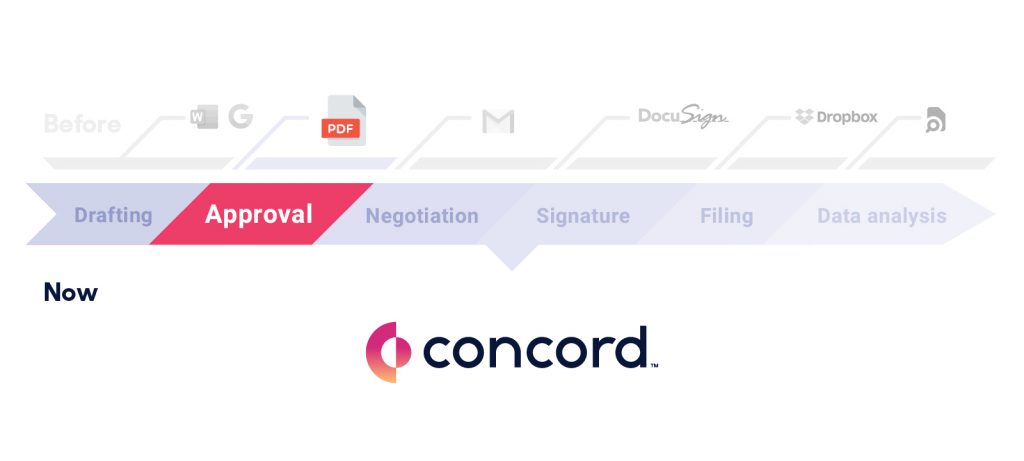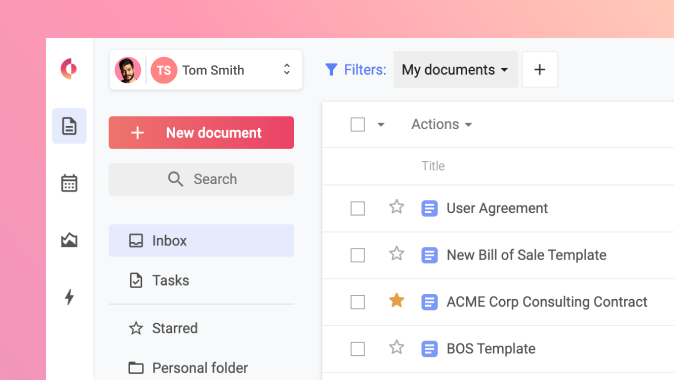Step 2 of the Agreement Lifecycle: Contract Administration
Table of contents
- Basics of Contract Administration: What is it?
- How the Approval Process Works
- Tips for Success in Managing Contract Revisions
- Helpful Contract Administration Tools
- Conclusion
-
About Concord
Effortless contract management, from drafting to e-signing and beyond. Book a live demo to see Concord in action.
Request demo
There’s a time and place for “old school” manual processes and tools. Great artisanship, or mechanical savvy come to mind. Respectfully, contract administration shouldn’t be one of them!
A recent Harvard Business Review (HBR) revealed that firms can lose 5 to 40 percent of value on a deal because of inefficient contract management.
Clearly, there’s a lot at stake in managing contracts correctly. Why go it alone? Instead, here’s how automating approval workflows is essential to better productivity, contracts, and value.
Basics of Contract Administration: What is it?
Contract Administration vs. Contract Management. These terms sound the same, but in your daily operations, they’re actually quite different!
Contract administration encompasses the first stages of entering into an agreement with another party.
These include:
- Defining terms, risk, and feasibility
- Deciding on key stakeholders, and signatories
- Drafting and reviewing the contract
Contract administrators work with stakeholders to oversee whether an agreement is in the best interest for your business. First of all, contract administration is a critical step in defining terms. Ultimately, this affects whether all parties can move forward successfully, and limit risk.
Whereas, contract management steers the agreement in the later stages of the process, says Chron. Contract administration doesn’t include the stages a contract manager would normally oversee, such as:
- Negotiation with third parties
- Ensuring legal signatures
- Tracking key terms
- Managing deadlines and renewals
- Maintaining a secure contract storage space
If you’re unsure about how your business should approach contract management, it’s helpful to learn about each contract stage, first.
Here are the stages of the Contract Lifecycle:
- Drafting a Contract
- Internal Approval of the Agreement (this article)
- Contract Negotiation
- Signing the Contract
- Securely Storing the Agreement
- Tracking Contracts and Documents
How the Approval Process Works
So what is an “approval process”, exactly? An approval workflow is a thoughtfully designed process that includes every party who needs to review and approve a contract.
In traditional terms, a paper contract went through many touch points before it was sent for signature. That internal process could be mired in impractical hold-ups. An attorney out of the office, an executive backed-up with other projects. All these could sidetrack the workflow.
Automating the approval workflow process mediates these delays with collaborative visibility. Additionally, it also safeguards risk so that only the right person is designated to approve a term, field, or section.
The approval workflow can be a complex process, but the best practice is to keep it as simple as possible.
For example, sales agreements, procurement agreements, and even rental agreements all have unique terms, deadlines, and financial conditions.
But what won’t likely change are the stakeholders required to review and approve these sections. An Account Manager, Sales Director, Legal, and Contract Administrator may always be the default parties for a Sales Agreement.
Tips for Success in Managing Contract Revisions
In a previous blog post, we discussed how to start drafting the agreement. Read more about starting a contract here. Now, let’s look into the next phase: the internal approval process

No matter your industry, you can almost always use these 3 questions to help you create an approval workflow:
- Who is responsible for reviewing each specific term first, and so on?
- Where will you get final approval, and for what terms?
- Which team member(s) is responsible for reviewing an agreement for risk, and when?
This will cut-down on poor communication, and unnecessary revisions.
Take ample time to work with stakeholders to answer these questions. It will make the hand-off for everyone involved easier. There’s nothing more frustrating for a team when you’ve landed a great new client, only to find out that terms you thought you could ensure aren’t sound for your business.
Now, the next step is to make sure everyone is aware of and agrees to a certain timeframe. More complex agreements might go through approval phases that can take up to 60 or 90 days.
Though, that’s typically more true in the government, healthcare, or education sector. For most SMBs and businesses that have a high volume of similar contracts, that process shouldn’t take months! An efficient approval workflow will decrease time-to-signature and approval delays.
Getting this process right, internally, is so critical that it means automating approval flows is practically a “must.”
Helpful Contract Administration Tools
You might already be aware that eSignatures decrease expenses and shorten the contract lifecycle. But connected tools on the whole increase employees’ productivity, says Inc., by 20 to 25 percent.
Let’s look at how automated approval workflow software works to increase productivity with Concord:
- Designate conditional approvals, based on terms you enter
- Send a contract to the right next person based on customized terms
- Set, then grab any pre-set workflow terms and approvals from a workflow library
- Track approvals and review status
- Make revisions in a private, secure space
Automating every leg of the work and approval process eliminates tedious oversight and errors. In tandem, you’re also able to discuss revisions within the process for true, real-time collaboration, and visibility.
The writing is no longer on the wall—it’s online! Digital agreement software that automates complex steps supports more effective contract administration. So, what should your organization look for? Software should be able to automate even the most time-consuming processes, like approval workflows, and deadline tracking.

Conclusion
Old-time processes are great for nostalgia, maybe, but not your bottom line. Most features in contract lifecycle management software can help you phase out manual contract management altogether.







